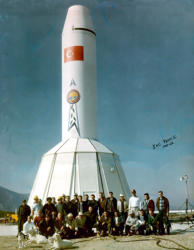
HISTORY - Page 84
Interest in such an undertaking was prompted by several factors. For one thing, intelligence had revealed
that the Russians were definitely working toward satellites, so the project had a politico-technological
value to this nation. Besides that, there was a high-altitude aircraft development project—the X-15—that
was slated to attain heights of from 100 to 150 miles, and little data was available as to the environment
the pilot or the aircraft would face. Thus, a minimum satellite (uninstrumented) could be launched to
perfect launching techniques, study orbital behavior, and devise tracking methods.
Once this was accomplished, more sophisticated satellites could be placed in orbit that had the capability
to gather data on conditions outside the sensible atmosphere. The artificial satellites could also be a part
of the International Geophysical Year (IGY)
126
.
Just prior to the time that a decision was made as to the course the program would follow, the Air Force
and Navy presented DOD with a new instrumented concept based on the VIKING missile. This became
known as the VANGUARD program. DOD appointed an ad hoc committee to weigh all the proposals, and
the committee chose the VANGUARD approach, based on the contention that the cost would be less and
that the Army plan was marginal in assuring success. Their main complaint was against the 75,000 pound
thrust REDSTONE power plant
127
. Ironically, when EXPLORER I was boosted into orbit, a slightly more
efficient fuel was used to boost the thrust to 83,000 pounds
128
.
_____________________________







126. Memo to Rear Adm F. R. Furth & Maj Gen L. E. Simon, 14 Dec 54, subj: Conf on Project Orbiter, and attachments, Hist Off files.
127. Rpt of the Ad Hoc Advisory Group on Spec Capabilities. OASD (R&D), Aug 55, Hist Off files.
128. Hist, ABMA, Jan-Jun 58, p. 102, Hist Off files.



Jupiter SM-78 Weapon System
I&C Team 2, Çigli AB, Turkey 1961-1962 Chrysler Corporation Missile Division

HISTORY - Page 85
Interest in such an undertaking was prompted by
several factors. For one thing, intelligence had
revealed that the Russians were definitely working
toward satellites, so the project had a politico-
technological value to this nation. Besides that, there
was a high-altitude aircraft development project—the
X-15—that was slated to attain heights of from 100 to
150 miles, and little data was available as to the
environment the pilot or the aircraft would face. Thus,
a minimum satellite (uninstrumented) could be
launched to perfect launching techniques, study
orbital behavior, and devise tracking methods.
Once this was accomplished, more sophisticated
satellites could be placed in orbit that had the
capability to gather data on conditions outside the
sensible atmosphere. The artificial satellites could also
be a part of the International Geophysical Year (IGY)
126
.
Just prior to the time that a decision was made as to
the course the program would follow, the Air Force and
Navy presented DOD with a new instrumented
concept based on the VIKING missile. This became
known as the VANGUARD program. DOD appointed an
ad hoc committee to weigh all the proposals, and the
committee chose the VANGUARD approach, based on
the contention that the cost would be less and that
the Army plan was marginal in assuring success. Their
main complaint was against the 75,000 pound thrust
REDSTONE power plant
127
. Ironically, when EXPLORER I
was boosted into orbit, a slightly more efficient fuel
was used to boost the thrust to 83,000 pounds
128
.
_____________________________
126. Memo to Rear Adm F. R. Furth & Maj Gen L. E. Simon, 14 Dec 54, subj: Conf on Project
Orbiter, and attachments, Hist Off files.
127. Rpt of the Ad Hoc Advisory Group on Spec Capabilities. OASD (R&D), Aug 55, Hist Off files.
128. Hist, ABMA, Jan-Jun 58, p. 102, Hist Off files.





















